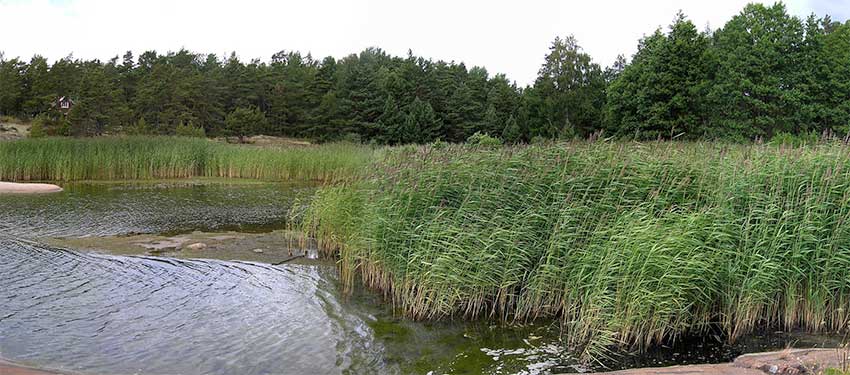Those reeds that are taller than you are? Invasive phragmites.

A previously sandy beach invaded by Phragmites australis. Photo: Jancke, Creative Commons, some rights reserved
Move over cattails, there’s a new top dog in town: Phragmites(frag MY tease) australis. Not a dog, really, but an invasive plant that becomes “top dog” in wetlands when introduced. It’s taller and more aggressive than cattails and other native plants, and edges them out of wetlands ecosystems. Its official genus, Phragmites, doesn’t exactly roll off one’s tongue, so people use the nickname “phragmites” for short (we all know italicized words are harder to pronounce).
Unfortunate name or not, it’s good to know about this perennial reed that can reach up to eighteen feet tall. Even in lake-effect snow areas of upstate New York its tan, plume-like tassels can be seen all winter long waving above the snow. Phragmites is easy to spot along margins of wetlands throughout the Northeast, especially in areas with recent site disturbance.
The problems with phragmites are numerous. It forms expansive, dense monocultures which have little or no food value to wildlife. Its habitat value is limited as well. While a handful of bird species like the least bittern nest within it, waterfowl and mammals such as muskrat cannot. Even deer have a tough time getting through tracts of phragmites.
Native plants are shaded out by its height and crowded out by the density of its stems and root system. Phragmites reduces access to waterways for birdwatching, boating, fishing and swimming, and blocks scenic views. In addition, its dry stalks can become a fire hazard in late winter and early spring.
Most likely of European origin, Phragmites australis arrived at the east coast of North America in the early 1800s. The development of highways, rail lines and utility corridors in the 20thcentury hastened its rate of spread. A native species of Phragmites is found along the eastern seaboard of the US, but it’s relatively rare.
Phragmites advances by means of fast-growing horizontal roots, or rhizomes, as well as through above-ground horizontal stems called stolons. Its rhizomes can grow outward thirty feet in a year, and have been known to sprout through asphalt. Impressive as these abilities are, humans disperse it miles at a clip by moving soil and contaminated equipment. It only takes a fragment of a rhizome to start a new phragmites infestation.
Seed dispersal by animals or wind can also play a role in its spread. In some cases phragmites has been intentionally planted for its value in adding texture and motion to the winter landscape.
Control strategies are situation-dependent. Where water levels can be managed, flooding infested areas for several months can destroy phragmites roots. Conversely, in places dry enough to mow, regular mowing for several years will eventually bring it to heel. Very often, though, neither strategy is available, and herbicide treatment is required.
The least-objectionable chemical for wetlands use is glyphosate, the active ingredient in herbicides like Roundup. Glyphosate is applied to phragmites by licensed applicators in late summer, and the chemical finds its way to the root system. Most often, a follow-up treatment is necessary the next summer. Mowing at two-three weeks post-treatment is considered helpful. A permit from the NYS Department of Environmental Conservation and/or from the U.S. Army Corps of Engineers may be required for herbicide treatment in wetlands areas.
General control measures include limiting (or eliminating) lawn chemicals and restoring natural water flow through wetlands. It’s imperative to clean heavy equipment between moves. Skidders, excavators, bulldozers and other equipment can spread phragmites and other invasive plant species.
For more information, visit NY Invasive Species Information, Great Lake Phragmites Collaborative, or SELO Partnership for Regional Invasive Species Management.
Paul Hetzler is a horticultuist for Cornell Cooperative Extension of St. Lawrence County
Tags: emvironment, invasive species







